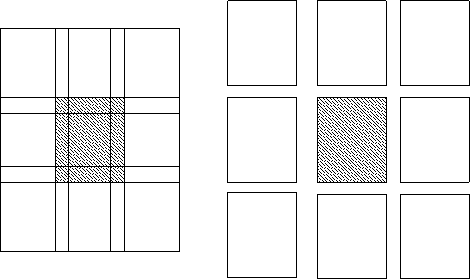|
rayab2D
Figure 1 Left is space of inputs and outputs. Right is during analysis. |  |
![[*]](http://sepwww.stanford.edu/latex2html/prev_gr.gif)
There are many reasons for cutting data planes or image planes into overlapping pieces (patches), operating on the pieces, and then putting them back together again, as depicted in Figure 1. The earth's dip varies with lateral location and depth. The dip spectrum and spatial spectrum thus also varies. The dip itself is the essence of almost all earth mapping, and its spectrum plays an important role in the estimation any earth properties. In statistical estimation theory, the word to describe changing statistical properties is ``nonstationary''.
|
rayab2D
Figure 1 Left is space of inputs and outputs. Right is during analysis. |  |
We begin this chapter with basic patching concepts
along with supporting utility code.
As in Chapters ![[*]](http://sepwww.stanford.edu/latex2html/cross_ref_motif.gif) and
and ![[*]](http://sepwww.stanford.edu/latex2html/cross_ref_motif.gif) ,
I exhibit two-dimensional subroutines only.
Three-dimensional code is an easy extension,
which is in the library (CD-ROM and web)
but not displayed (to reduce clutter).
The language of this chapter,
patch,
overlap,
window,
wall,
is two-dimensional,
but it may as well be three-dimensional,
cube,
subcube,
brick,
or one-dimensional,
line,
interval.
Then we examine some two-dimensional, time- and space-variable applications:
adaptive steep-dip rejection,
noise reduction by prediction,
and segregation of signals and noises.
,
I exhibit two-dimensional subroutines only.
Three-dimensional code is an easy extension,
which is in the library (CD-ROM and web)
but not displayed (to reduce clutter).
The language of this chapter,
patch,
overlap,
window,
wall,
is two-dimensional,
but it may as well be three-dimensional,
cube,
subcube,
brick,
or one-dimensional,
line,
interval.
Then we examine some two-dimensional, time- and space-variable applications:
adaptive steep-dip rejection,
noise reduction by prediction,
and segregation of signals and noises.
![[*]](http://sepwww.stanford.edu/latex2html/prev_gr.gif)